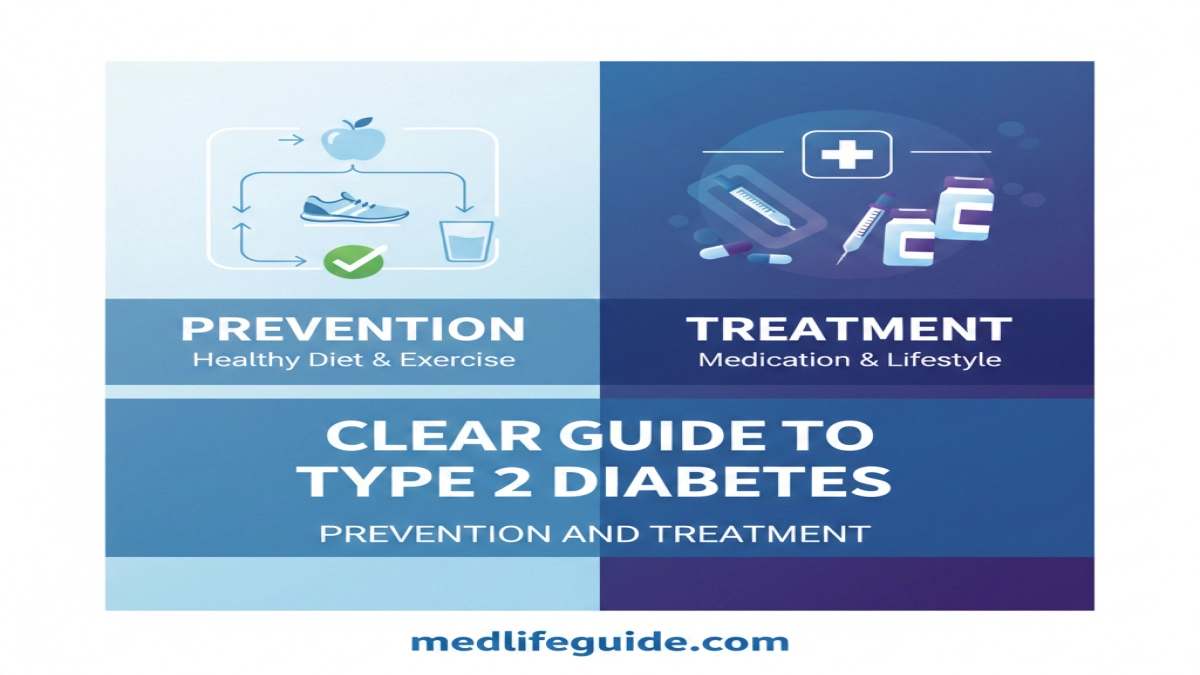Medically Reviewed and Compiled by Dr. Adam N. Khan, MD.
Introduction
Here’s the thing: type 2 diabetes does not develop overnight. It builds slowly as the body stops responding to insulin the way it should. The good news is that early steps can delay it, stop it, and even improve it. Let’s break it down in a way that’s clear, practical, and grounded in real medical science.
What Type 2 Diabetes Actually Is
Type 2 diabetes happens when the body becomes less sensitive to insulin. Over time, the pancreas cannot keep up, so blood sugar rises. High blood sugar harms blood vessels, nerves, and organs if it stays that way.
Main Risk Factors
Lifestyle-Related Risks
- Low physical activity
- High-calorie eating patterns
- Excess body weight
- Poor sleep habits
Medical Risks
- Prediabetes
- Family history of diabetes
- High blood pressure and abnormal cholesterol
Type 2 Diabetes Preventions and Treatments
This is the focus keyphrase. Here’s how prevention and treatment work hand in hand.
Prevention Strategies
- A daily 25 to 30 minute walk
- Balanced meals with portion control
- More whole grains, vegetables, lean proteins
- Cutting sugary drinks and reducing late-night eating
- Maintaining a healthy sleep routine
Medical Prevention for High-Risk Individuals
- Metformin for people with prediabetes
- Weight-loss medications when lifestyle alone is not enough
- Regular HbA1c screening for monitoring
Standard Treatments After Diagnosis
- Metformin as first-line
- GLP-1 receptor agonists when weight control is needed
- SGLT2 inhibitors for kidney and heart protection
- Insulin for advanced stages
- Ongoing monitoring of kidneys, eyes, and nerves
Unique Clinical Takeaways
These insights come from clinical practice and patient patterns that do not always show up in simple checklists.
1. Why Sleep and Stress Matter More Than Most People Realize
Many patients with borderline blood sugar show large improvements when they fix sleep timing and reduce stress. Stress hormones raise blood sugar. People who follow a consistent sleep schedule often see better fasting glucose even without big diet changes.
2. The Hidden Role of Meal Timing
It’s not just what you eat. It’s when you eat. Late-night meals spike glucose for hours because insulin sensitivity drops in the evening. Patients who shift heavier meals earlier in the day often improve their HbA1c by small but meaningful amounts.
3. Personal Metabolic Differences Change Treatment Success
Two people can eat the same meal and have very different blood sugar responses. Continuous glucose monitoring (CGM) helps identify personal trigger foods. This allows more precise treatment instead of a one-size-fits-all diet plan.
Symptoms to Watch For
Early Symptoms
- Increased thirst
- Frequent urination
- Fatigue
- Blurry vision
Advanced Symptoms
- Tingling in hands or feet
- Slow wound healing
- Recurrent infections
When to See a Doctor
- Family history with rising weight
- Prediabetes on lab reports
- Symptoms lasting more than two weeks
- History of gestational diabetes
References and Citations
- American Diabetes Association. Standards of Medical Care in Diabetes.
- Mayo Clinic. Type 2 Diabetes Overview and Treatment.
- Cleveland Clinic. Diabetes Risk Factors and Management.
- National Institute of Diabetes and Digestive and Kidney Diseases (NIDDK).
- The Lancet Diabetes & Endocrinology. Peer-reviewed studies on treatment outcomes.
Medical Disclaimer
This article is for education only. It does not replace medical evaluation, diagnosis, or treatment. Always speak with a licensed healthcare provider for personal medical decisions.

